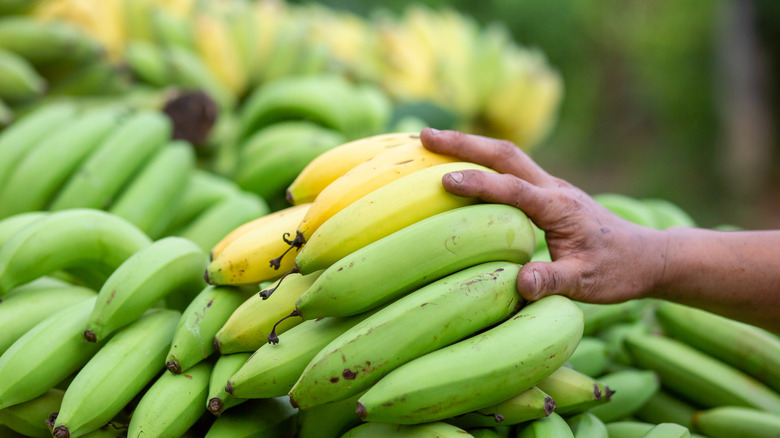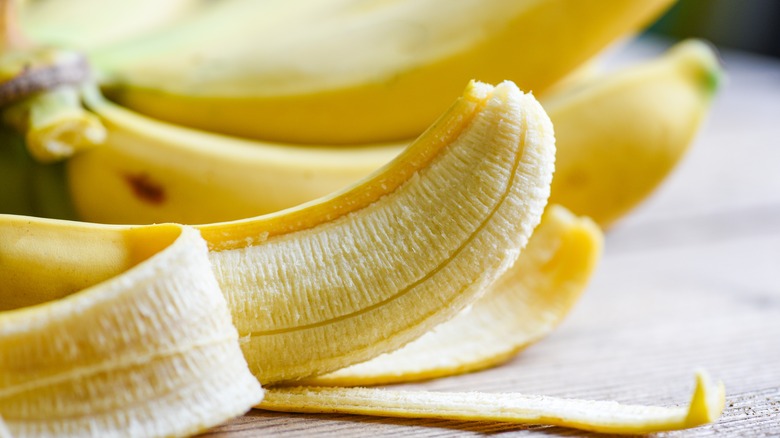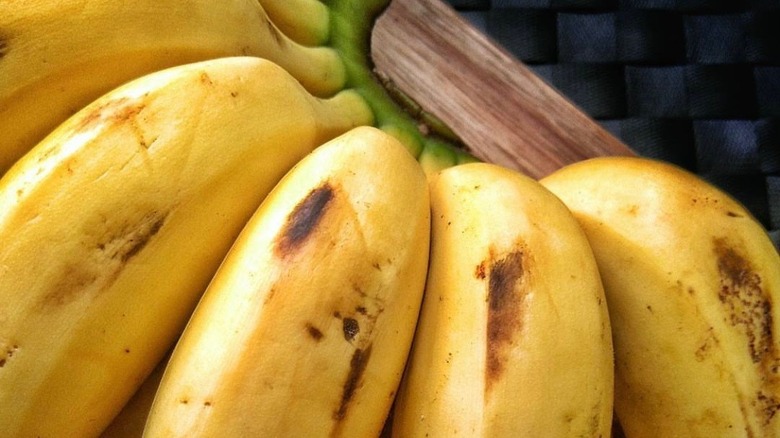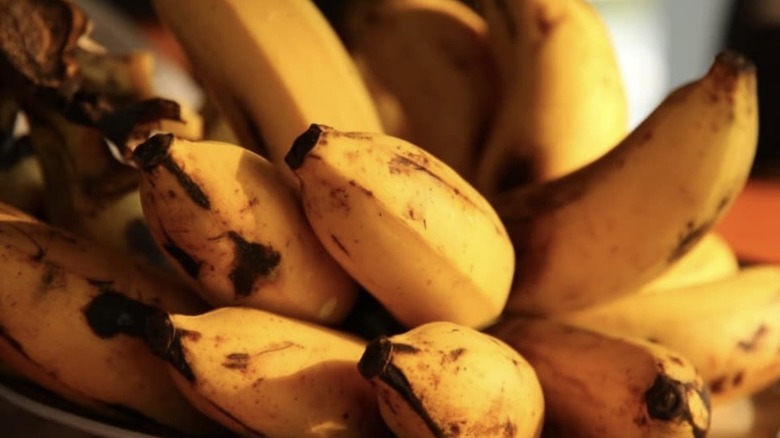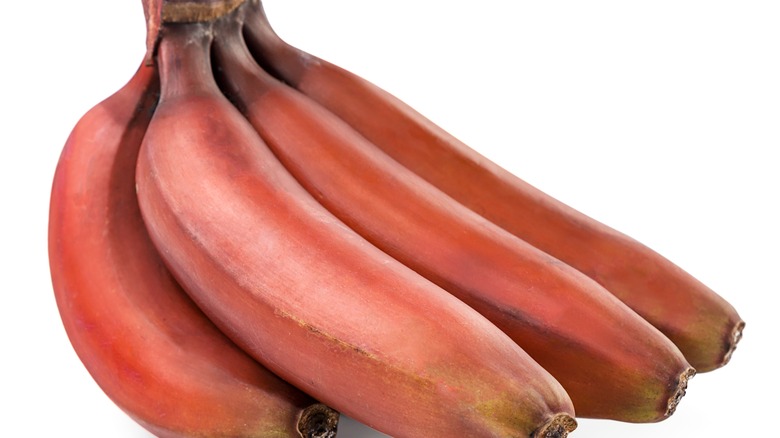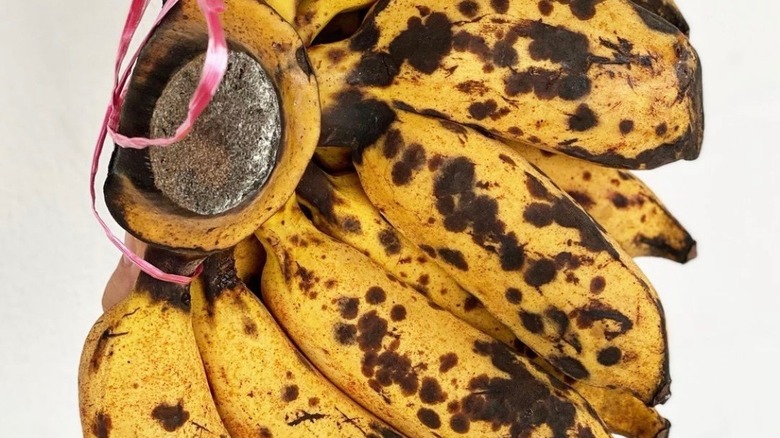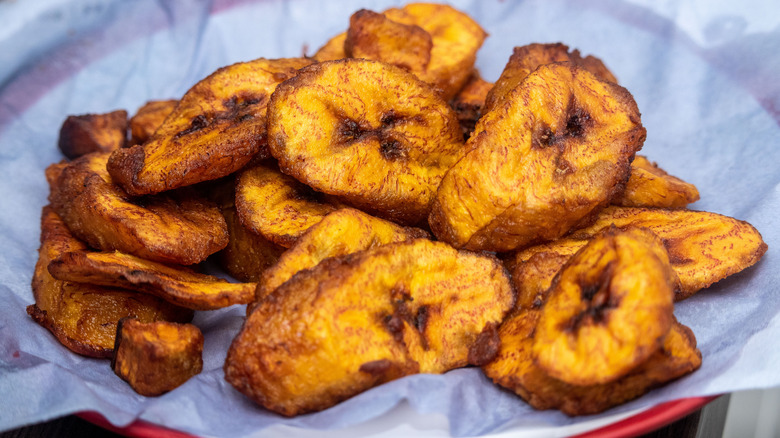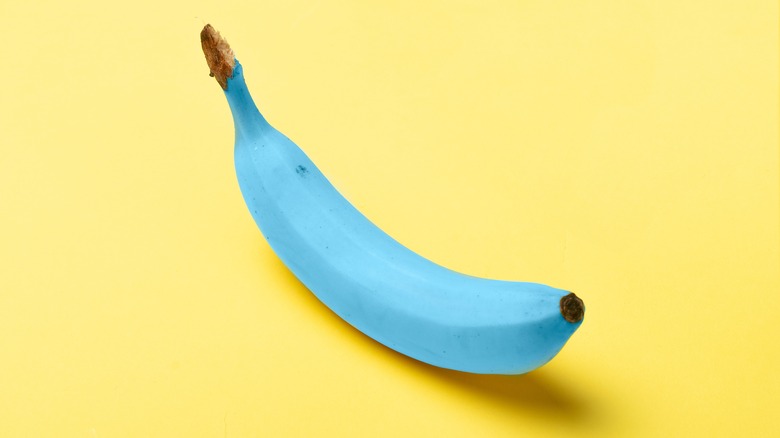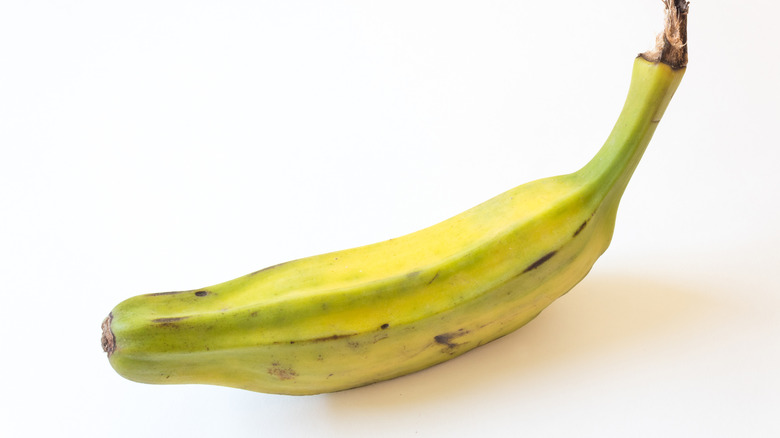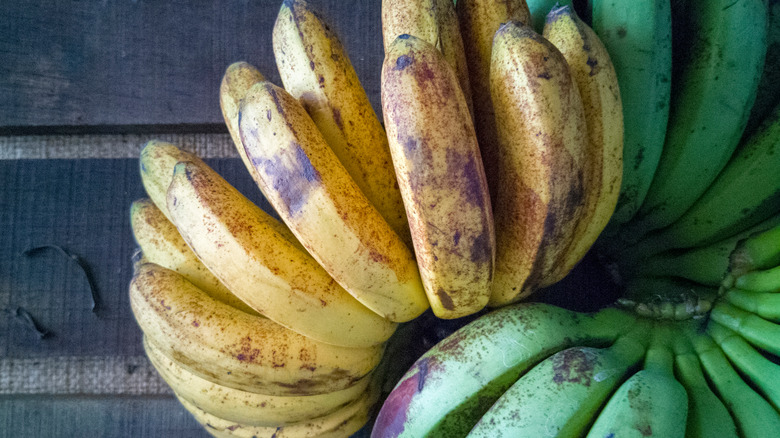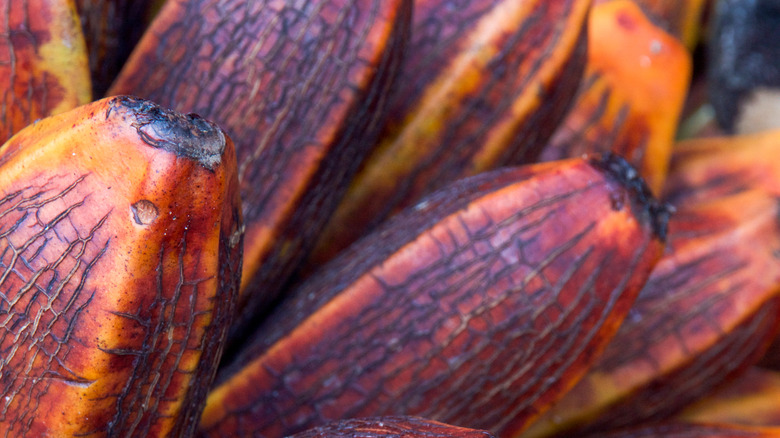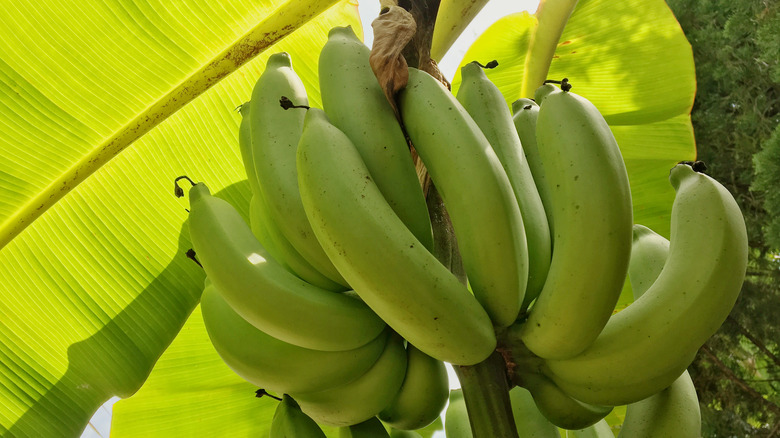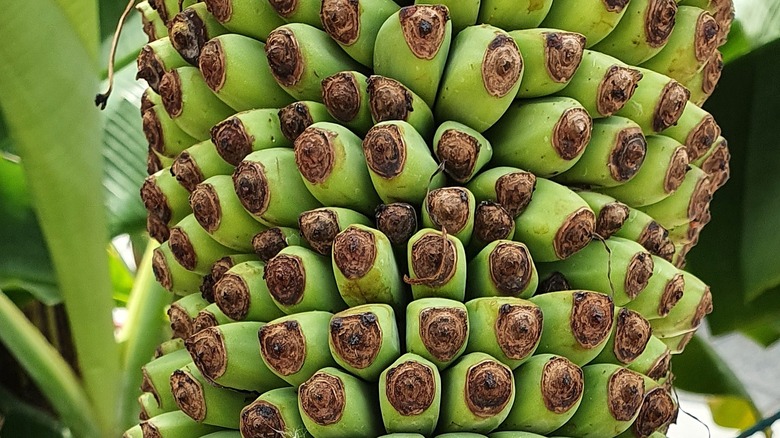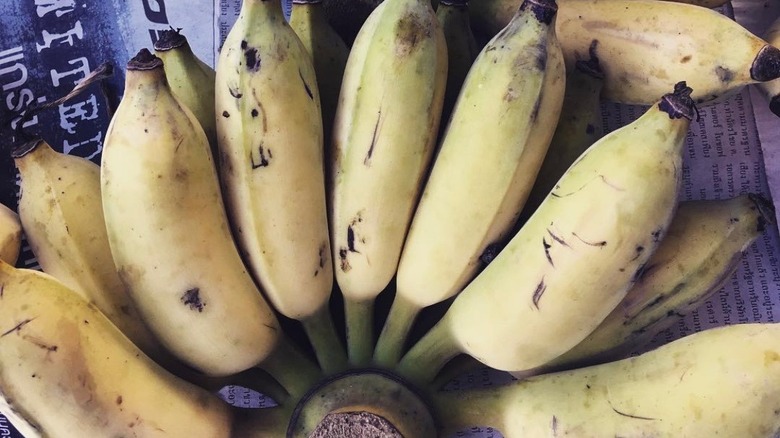13 Types Of Bananas, Explained
Why wouldn't you go bananas for bananas? These fruits are some of the most delicious on the planet and provide structure and flavor to numerous dishes including banana bread, fried plantains, and bananas foster. But how much do you really know about bananas?
According to the Encyclopedia Brittanica, bananas were originally cultivated in the Southeast Asian countries of Indonesia and Malaysia, but several historical figures like Alexander the Great wrote about bananas as far east as India. Once circumnavigation capabilities increased, the conquistadors began cultivating bananas in Hispaniola (modern Haiti and the Dominican Republic). The bananas made their way to the American kitchen around the 1800s — and for good reason. Per the Harvard School of Public Health, bananas are rich sources of prebiotic fiber, potassium, and carbohydrates.
The exact flavor and texture of the banana are dependent on its type. Here are some of the most popular bananas you'll find and what you can expect to use each kind for.
Cavendish bananas
Cavendish is the standard type of banana in the American supermarket. The Cavendish is long in shape and can go from an under-ripe shade of bright green to a ripe shade of dark yellow with brown spots. The exact desirable color of the Cavendish is based on personal preference. If you purchase under-ripe Cavendish, you can store the banana in a closed bag. As the banana ripens, it produced ethylene gas. On the other hand, if you want to slow the production of ethylene gas, you're better off hanging your fruit from a hook in the kitchen. Hanging the fruit allows more air to pass between the bananas, thus decreasing exposure to the ripening ethylene gas.
The mild, nuanced flavor of the Cavendish makes it useful for almost any application we can think of using a banana in. Freeze banana pieces in your freezer for a boost of fiber for your smoothie. Or, snack on the Cavendish with your favorite peanut butter in tow.
Apple bananas
No silly, we're not talking about apples and bananas — we're talking about a cultivar known as the "apple banana." The apple banana is much smaller and more compact than the Cavendish. The apple banana can also be known as the "candy apple banana" because of its sweetness, but also an underlying tang that makes this type kind of taste like an apple. According to Hawaiian Crown, the apple banana has firmer flesh than a Cavendish and tends to sell in bunches of up to ten bananas.
Cooks Info notes that the flesh of the apple banana is slow to turn brown after the fruit is peeled, thus making this type good for fruit salads, as well as general snacking. The portability and size of the apple banana compared to the Cavendish makes it a favorite among kids and lunchboxes across America. You can purchase apple bananas in your standard grocery store or at a local Asian market.
Lady Fingers bananas
Lady Finger bananas are named after the fruit's dainty appearance. The flavor of these bananas is similar to the standard Cavendish, but just in a smaller package. The standard Lady Finger banana is only about 3 to 5 inches in length and has sweet notes of honey. According to Minneopa Orchards, the Lady Finger banana can also be called the "baby banana" because of its size.
Regardless of size, the sweet flavor of these bananas makes the fruit an ideal pairing for peanut butter or chocolate. Minneopa Orchards also mentions that despite being super sweet, the Lady Finger is not high on the glycemic scale. This means that you can substitute the Lady Finger into your favorite baking recipe for the Cavendish if you want a sweeter taste without the spike in blood sugar. Send a Lady Finger banana with your child to school for a sensible portion of fruit paired with a favorite dip.
Red bananas
Red bananas are aptly named for the fruit's color. Although there are several cultivars under the umbrella of the "red banana," the fruit all share a similar red hue on the peel of the fruit. Healthline notes that the flavor of most red bananas has been described as "a hint of raspberry sweetness" along with the starchiness of a regular banana.
The red color of the banana is credited to the presence of beta carotene and lutein; both of these vitamin A precursors can help improve eye health. Red bananas also have higher amounts of antioxidants than Cavendish bananas — which in turn may decrease the risk of cancer, heart disease, and other chronic illnesses.
Outside of the nutritional benefits of the red banana, you should also seek out this type of banana for its unique flavor. Fine Dining Lovers recommends waiting until the bananas are soft to the touch in order to ensure ripeness. Add slices of red banana to banana bread or a breakfast parfait with berries and granola.
Pisang Raja
The Pisang Raja, also known as the Musa Belle, is a starchy banana commonly enjoyed in Indonesia. These bananas range in color from yellow to orange, and, according to The Florida Hill Nursery, are much larger than standard Cavendish. These bananas are usually eaten in dishes rather than as one person because of their size.
In Indonesia and Malaysia, the Pisang Raja is made into Indonesian fried bananas — otherwise known as pisang goreng. Per Daily Cooking Quest, the bananas are coated in a batter made with rice flour, sugar, water, leavening agents, and turmeric (for color). After the bananas are ready, the fruits are fried for a few minutes before being served hot. Although other types of bananas and plantains can be used for pisang goreng, the Pisang Raja is preferred for its neutral flavor and size. If you make this recipe at home, you should use Pisang Raja's that are ripe (dark yellow with brown spots) to ensure a good flavor and frying experience.
Cooking bananas
There are several differences between bananas and plantains — otherwise known as a cooking banana. Plantains are longer and have more starch than bananas. As a result, most preparations of the plantain involve cooking, while the Cavendish banana is usually consumed raw. Many cultures use plantains as a starch like the way many Americans use potatoes; the fruit can become quite sweet when it is fried with oil and salt, baked, or boiled.
For a more unconventional preparation of your plantains, try grilling peel-on. You can cook the plantains on the grill for about 30 minutes, carefully keeping the fruit away from direct heat. Once the sugars from the plantain start to ooze out of the peel, you know your plantains are ready to eat. Season your plantains with salt and serve alongside other Puerto Rican foods like pernil (roasted pork), arroz con gandules (rice and beans), and an arroz con dulce (sweetened rice) dessert.
Blue Java bananas
Usually, when fruit is blue, it's a bad sign. But not when we're talking about Blue Java bananas.
Blue Java bananas are often referred to as the "ice cream banana." The Blue Java variety has a distinct blue hue that sets the variety apart from other bananas, per Healthline. Under-ripe Blue Java bananas lose the blue hue as the fruit ripens. But the magic of these bananas doesn't stop there — open the banana to reveal a custardy-flavored fruit with small black seeds. The Blue Java is a little more stout in appearance compared to a traditional Cavendish.
The vanilla flavor and sweetness of the Blue Java make it a popular eating and dessert banana in its endemic regions of Southeast Asia. If you're lucky to find one of these bananas in a grocery store or market, try to add the flesh to one-ingredient ice cream with your favorite nuts, candy, or fruit topping.
Burro bananas
According to the Produce Market Guide, the burro banana is identified for its rectangular shape and dark green peels. Once the banana is peeled, it reveals a white or yellow flesh with undertones of lemon. The average burro banana is about 6 inches long and can be cooked or served raw.
Burro bananas, or the type otherwise known as a "chunky banana," "horse banana," or "Orinoco," can be made into many dishes including baked burro bananas with butter, brown sugar, and warming spices. Mexico in My Kitchen notes that several Mexican recipes use the burro banana since the fruit is native to the region. You can place the banana in a skillet (peel on) and roast until the sugar in the banana starts to seep out of the peel. The banana is then covered in milk, sugar, and warming spices for a quick, sweet, and simple dessert option.
Pisang Berangans
Per HerbalWise, the Pisang Berangan is a Malaysian banana that can grow between 10 and 16 centimeters in length. The Pisang Berangan is best consumed ripe, which is indicated by a dark yellow or light orange hue with small black spots. The semi-sweet banana is often served in Malaysia as a dessert cultivar because of its subtle acidity and mild flavor. In Malaysia, the Pisang Berangan is usually just eaten out of hand as a snack or a dessert, but the fruit's texture and flavor lends well to cooking and baking.
For optimal flavor, the Pisang Berangan is best paired with chocolates, pistachios, pecans, or tropical fruits like mangos and pineapple. You can caramelize the Pisang Berangan with butter for a take on a bananas foster or slice and add the fruit to a banana cheesecake. If you're looking for a creative dessert to serve at your next gathering, try banana lumpia — a dessert from the Philippines made by slicing ripe bananas, coating in brown sugar, and wrapping the fruit in egg-roll sheets. The rolls are then fried and served with a decadent sprinkle of powdered sugar.
Fe'i bananas
The Fe'i banana variety is often grown in Tahiti for both construction and as an important food source (via ProMusa). The leaves of the plant can be used for plates and roofing material, while the plant's sap can be used as a textile dye. Unlike the yellow Cavendish variety, the Fe'i is bright amber in color with prominent ridges running down the exterior of the fruit. The interior of the banana can be yellow to dark depending on the ripeness of the fruit. According to the Food and Agriculture Organization, the dark variety of the Fe'i banana has 200 times more carotenoids than the Cavendish banana.
The Fe'i is best suited for cooking, grilling, and roasting. The Fe'i has the starchiness of a plantain but some of the sweetness of a standard Cavendish banana. You'll find the Fe'i used as a complement to meat and fish because it retains its shape during cooking.
Gros Michel
Miami Fruit notes the Gros Michel was the prominent variety of bananas in American grocery stores between 1870 and 1950 before the takeover of the Cavendish. The Gros Michel is not common in grocery stores now because of the Panama Disease outbreak in the 1950s, which almost eliminated the variety. Now, some specialty growers continue growing the fruit, but you are unlikely to find it in most grocery stores.
The Gros Michel is nicknamed "Big Mike" not for its size, but for its flavor. According to Atlas Obscura, there is very little difference between the appearance of the Cavendish and the Gros Michel. Besides a slightly silkier peel, you likely wouldn't be able to tell a difference between the two. Atlas Obscura goes on to describe the flavor as "tangy and complex" with a creamier texture than other banana varieties. There is also another potential scientific breakthrough on the horizon for what is left of the Gros Michel; ABC Rural notes that Japanese food scientists are trying to engineer a descendant of the Gros Michel to have an editable skin.
Thousand Fingers bananas
You likely won't ever see a banana plant that looks quite like a Thousand Fingers banana plant. Per Singapore's National Parks' website, Thousand Fingers bananas only grow to 1½ inches long. Thousand Fingers are seedless with a dark green prior to ripening and a gradual shift to yellow. In a matter of a few weeks, the Thousand Fingers banana tree can grow up to 12 feet tall and the fruits grow around the stem of the tree while it matures. One of these banana plants can grow up to a thousand bananas in its short life — as the name would suggest.
Although these bananas are tedious to peel due to their size, the Thousand Fingers bananas replicate the same taste and texture as a Cavendish. You can eat these bananas raw after signs of ripeness emerge, or bake the bananas into 5-ingredient banana bread cookies with almond flour, baking soda, cinnamon, and the sweetener of your choice.
Thai bananas
According to Specialty Produce, Nam Wah (Thai) bananas grow in pairs along the tree's central stalk. The fruits are about the size of the Cavendish at between 10 and 13 centimeters in length. As the Thai banana ripens, it transitions from green to yellow to dark black. Ripe bananas will have a sweet, creamy taste, while underripe Nam Wah bananas will have a more acidic flavor. In Vietnam, the stems of the Thai banana are often fed to livestock while the peels are boiled and used to make a flavorful, nutritious tea.
The Thai banana is most commonly used for cooking, but it can be eaten raw. Ripe Thai bananas are mashed and cooked into a Vietnamese dish called choui chien. These street food fried bananas are made by frying the banana mash in a batter of rice and all-purpose flour. The bananas can also be cut into chunks, boiled, and used to make puddings and creams.
